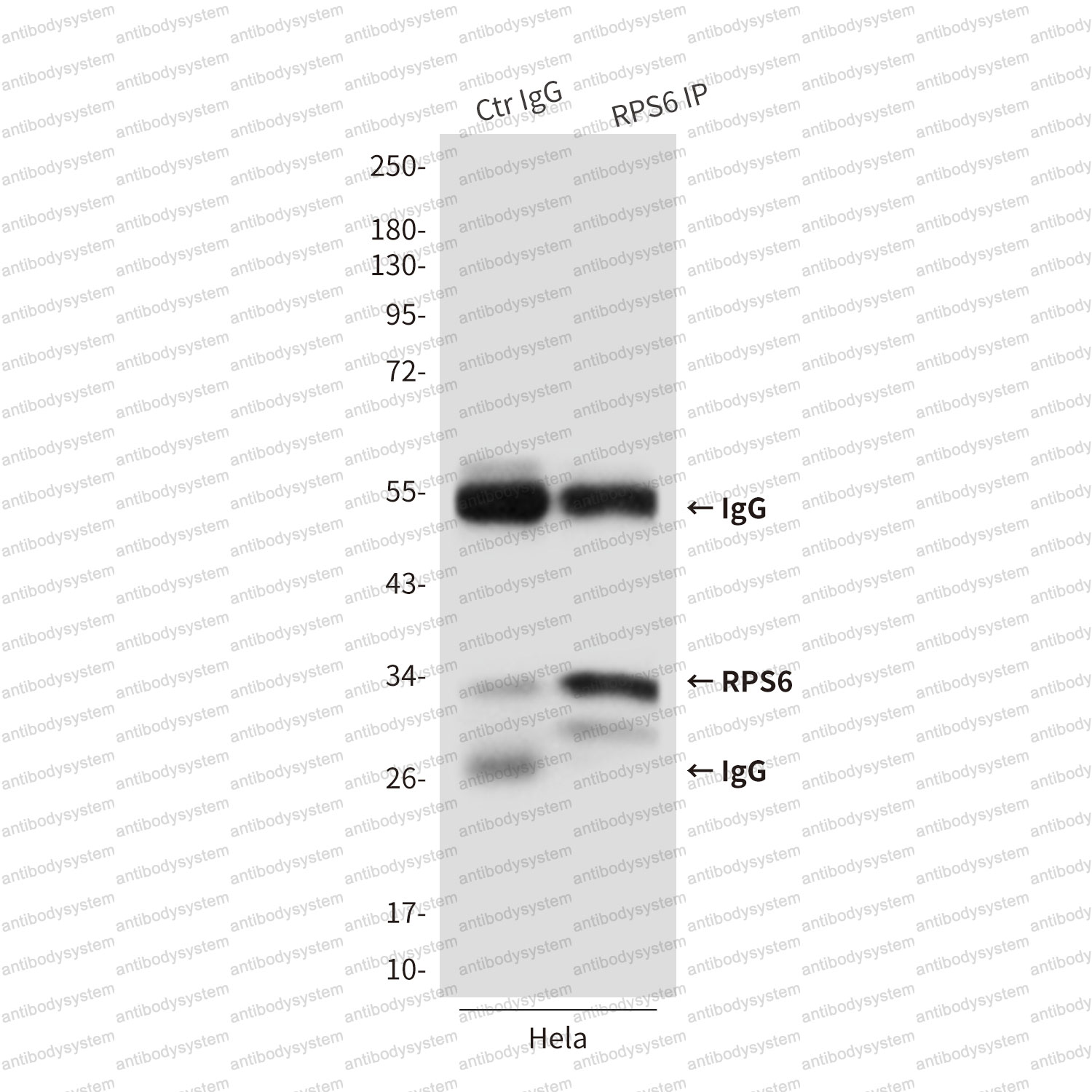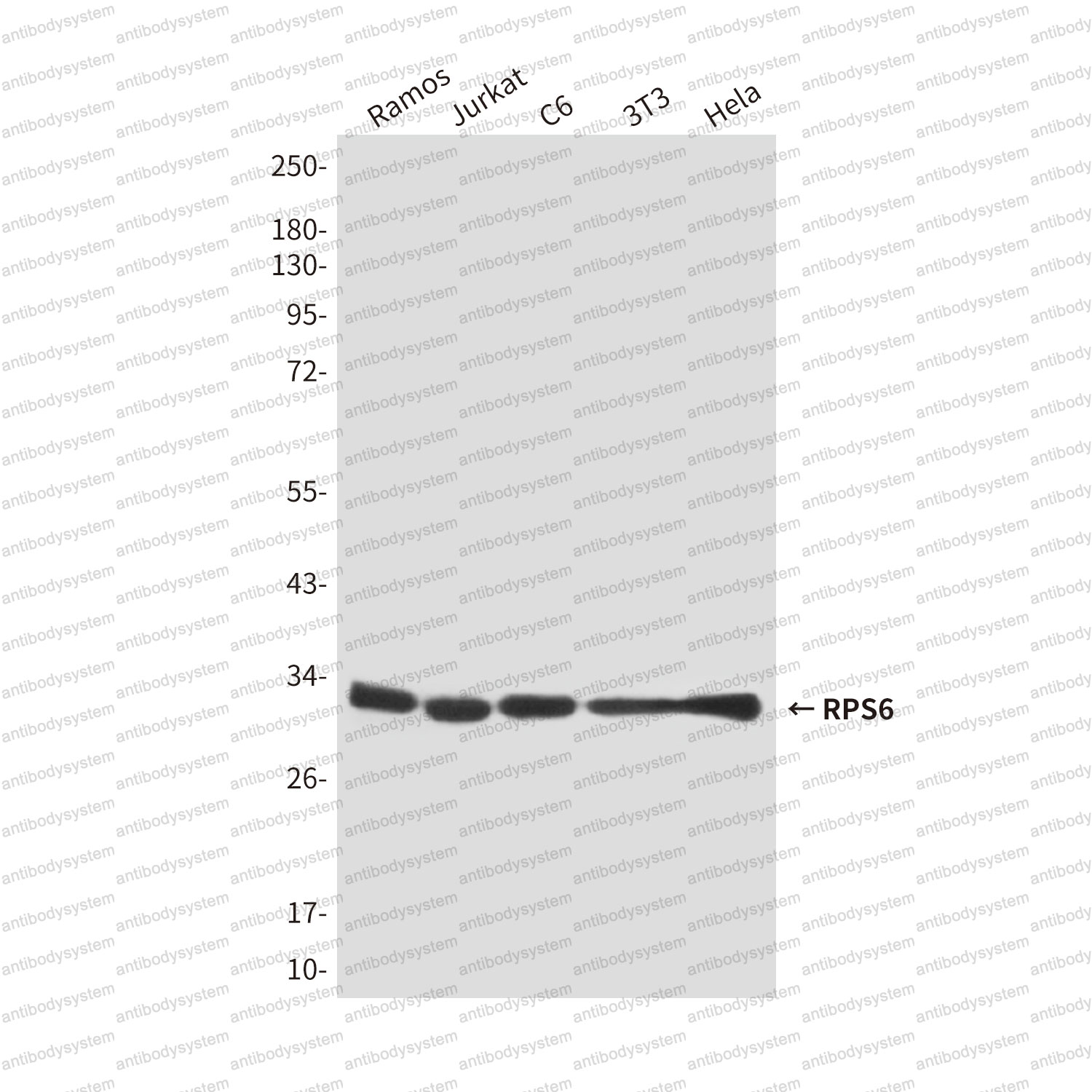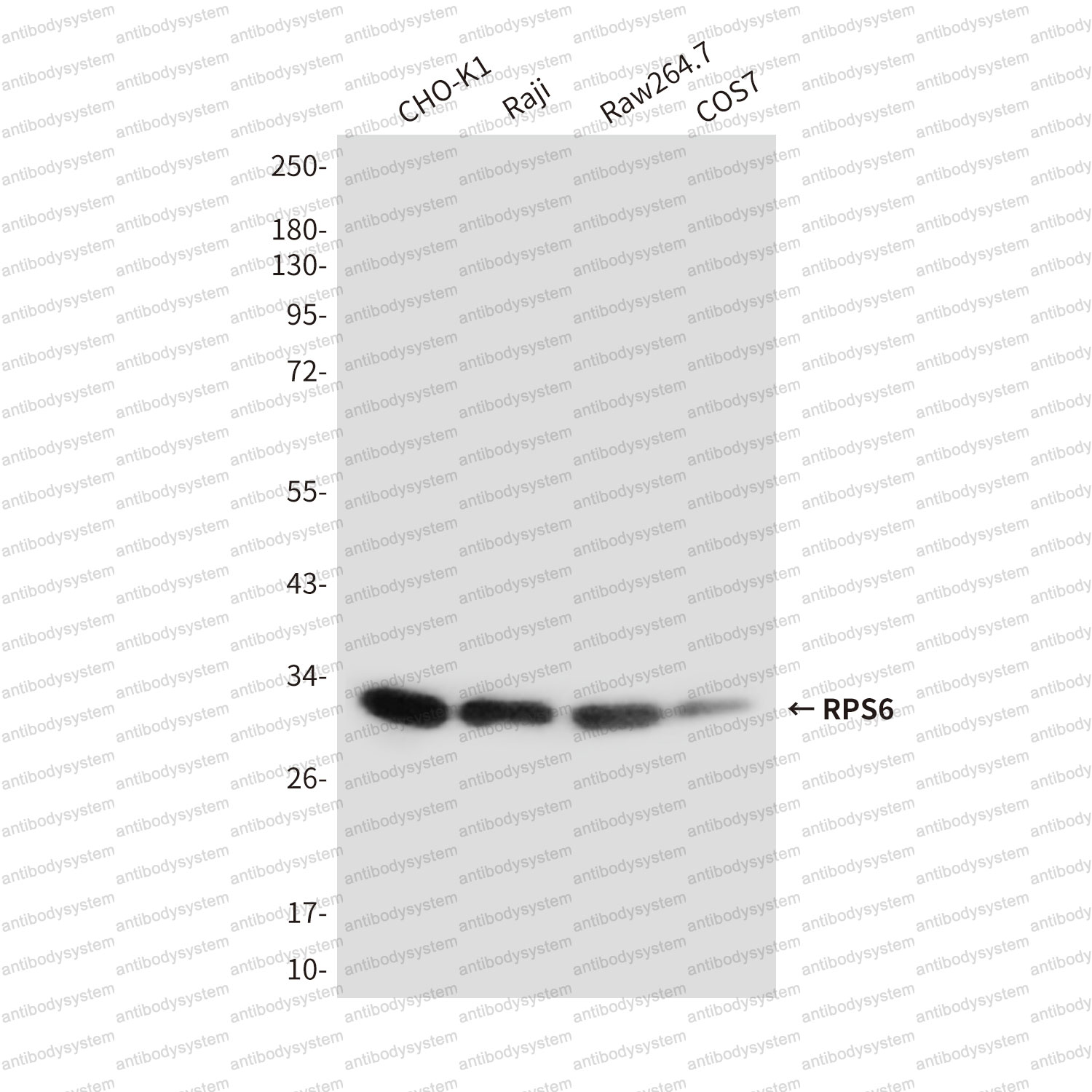Catalog No.
RHF53002
Species reactivity
Human, Mouse, Rat, Monkey
Host species
Mouse
Isotype
IgG1
Clonality
Monoclonal
Tested applications
IF: 1:50-1:200, IP: 1:20, WB: 1:500-1:1000
Target
40S ribosomal protein S6, Phosphoprotein NP33, RPS6, Small ribosomal subunit protein eS6
Concentration
1 mg/ml
Endotoxin level
Please contact with the lab for this information.
Purity
>95% as determined by SDS-PAGE.
Purification
Protein A/G purified from cell culture supernatant.
Accession
P62753
Applications
IF, IP, WB
Form
Liquid
Storage buffer
0.01M PBS, pH 7.4, 0.5% BSA, 0.05% Sodium Azide and 50% Glycerol.
Stability and Storage
Use a manual defrost freezer and avoid repeated freeze-thaw cycles. Store at 4°C short term (1-2 weeks). Store at -20°C 12 months. Store at -80°C long term.
Clone ID
R3P16
Development and application of a targeted phosphoproteomics method for analysing the mTOR pathway dynamics in zebrafish PAC2 cell line., PMID:40466985
Synergistic activity of tafasitamab and metronomic chemotherapy on diffuse large B-cell lymphoma through inhibition of the AKT/mTOR signaling pathway., PMID:40175588
Protocol for the visualization of pRps6-positive cells in larval zebrafish brains using whole-mount immunofluorescence and light-sheet microscopy., PMID:39827458
Immunofluorescence for Detection of TOR Kinase Activity In Situ in Photosynthetic Organisms., PMID:39735298
PARP1 acetylation at K119 is essential in regulating the progression and proliferation of cervical cancer cells., PMID:39400626
Elevated antibody binding to striatal cholinergic interneurons in patients with pediatric acute-onset neuropsychiatric syndrome., PMID:39084540
Quantitative proteomics profiling reveals the inhibition of trastuzumab antitumor efficacy by phosphorylated RPS6 in gastric carcinoma., PMID:37507485
Evaluation of the mTORC activity in the presence of Toxoplasma gondii and azathioprine in human monocyte cell line., PMID:36941573
In silico development and experimental validation of a novel 7-gene signature based on PI3K pathway-related genes in bladder cancer., PMID:35896848
Chip-DSF: A rapid screening strategy for drug protein targets., PMID:35809766
Aniridia-related keratopathy relevant cell signaling pathways in human fetal corneas., PMID:35551459
PI3K/AKT/mTOR signaling pathway activity in IDH-mutant diffuse glioma and clinical implications., PMID:35287169
A phospho-proteomic study of cetuximab resistance in KRAS/NRAS/BRAFV600 wild-type colorectal cancer., PMID:34462871
Knockdown of SASS6 reduces growth of MDA‑MB‑231 triple‑negative breast cancer cells through arrest of the cell cycle at the G2/M phase., PMID:33907854
PCR Array Technology in Biopsy Samples Identifies Up-Regulated mTOR Pathway Genes as Potential Rejection Biomarkers After Kidney Transplantation., PMID:33681239
Isoform- and Phosphorylation-specific Multiplexed Quantitative Pharmacodynamics of Drugs Targeting PI3K and MAPK Signaling in Xenograft Models and Clinical Biopsies., PMID:33536190
Comparison of regulatory networks of E74-like factor 1 and cold-shock domain-containing E1 in breast cancer cell lines using ChIP datasets., PMID:33178343
Non-invasive High Frequency Repetitive Transcranial Magnetic Stimulation (hfrTMS) Robustly Activates Molecular Pathways Implicated in Neuronal Growth and Synaptic Plasticity in Select Populations of Neurons., PMID:32612497
Peptide SMIM30 promotes HCC development by inducing SRC/YES1 membrane anchoring and MAPK pathway activation., PMID:32461121
Affinity-Bead Assisted Mass Spectrometry (Affi-BAMS): A Multiplexed Microarray Platform for Targeted Proteomics., PMID:32188029
TGF-β1 inhibits the autophagy of podocytes by activating mTORC1 in IgA nephropathy., PMID:31600491
Modulating EGFR-MTORC1-autophagy as a potential therapy for persistent fetal vasculature (PFV) disease., PMID:31462148
Rapamycin Prevents Surgery-Induced Immune Dysfunction in Patients with Bladder Cancer., PMID:30563829
Altered Signaling Pathways in Aniridia-Related Keratopathy., PMID:30480741
MiR-129-5p Sensitizes the Response of Her-2 Positive Breast Cancer to Trastuzumab by Reducing Rps6., PMID:29258115
Synaptically driven phosphorylation of ribosomal protein S6 is differentially regulated at active synapses versus dendrites and cell bodies by MAPK and PI3K/mTOR signaling pathways., PMID:28716954
IL-3 up-regulates and activates human eosinophil CD32 and αMβ2 integrin causing degranulation., PMID:28000949
The Arabidopsis TOR Kinase Specifically Regulates the Expression of Nuclear Genes Coding for Plastidic Ribosomal Proteins and the Phosphorylation of the Cytosolic Ribosomal Protein S6., PMID:27877176
Signaling pathways controlling activity-dependent local translation of BDNF and their localization in dendritic arbors., PMID:27270670
Synaptic activation of ribosomal protein S6 phosphorylation occurs locally in activated dendritic domains., PMID:27194793
Phenotypically Dormant and Immature Leukaemia Cells Display Increased Ribosomal Protein S6 Phosphorylation., PMID:26985829
A single 60-min bout of peristaltic pulse external pneumatic compression transiently upregulates phosphorylated ribosomal protein s6., PMID:26769680
Phosphorylated ribosomal S6 (p-rpS6) as a post-treatment indicator of HER2 signalling targeted drug resistance., PMID:26329528
Immunohistochemical Assessment of Phosphorylated mTORC1-Pathway Proteins in Human Brain Tumors., PMID:25993328
Response to dual HER2 blockade in a patient with HER3-mutant metastatic breast cancer., PMID:25953157
TORC1 promotes phosphorylation of ribosomal protein S6 via the AGC kinase Ypk3 in Saccharomyces cerevisiae., PMID:25767889
Protein phosphorylation profiling identifies potential mechanisms for direct immunotoxicity., PMID:25715851
Ductal adenocarcinoma of the pancreas usually retained SMAD4 and p53 protein status as well as expression of epithelial-to-mesenchymal transition markers and cell cycle regulators at the stage of liver metastasis., PMID:25119169
Attenuation of replication stress-induced premature cellular senescence to assess anti-aging modalities., PMID:24984966
Boolean ErbB network reconstructions and perturbation simulations reveal individual drug response in different breast cancer cell lines., PMID:24970389
Mapping pathological phenotypes in a mouse model of CDKL5 disorder., PMID:24838000
Anthrax lethal toxin inhibits translation of hypoxia-inducible factor 1α and causes decreased tolerance to hypoxic stress., PMID:24366872
Sym004, a novel EGFR antibody mixture, can overcome acquired resistance to cetuximab., PMID:24204198
Evaluation of EGFR and RTK signaling in the electrotaxis of lung adenocarcinoma cells under direct-current electric field stimulation., PMID:23951353
Targeting AKT with the allosteric AKT inhibitor MK-2206 in non-small cell lung cancer cells with acquired resistance to cetuximab., PMID:23760490
Regulation of the ERK pathway in the dentate gyrus by in vivo dopamine D1 receptor stimulation requires glutamatergic transmission., PMID:22796106
Relationship between ATM and ribosomal protein S6 revealed by the chemical inhibition of Ser/Thr protein phosphatase type 1., PMID:22451389
Tetraspanins stimulate protein synthesis in myeloma cell lines., PMID:22415769
Strong EGFR signaling in cell line models of ERBB2-amplified breast cancer attenuates response towards ERBB2-targeting drugs., PMID:23552733
A genome-wide RNAi screen for polypeptides that alter rpS6 phosphorylation., PMID:22125066




